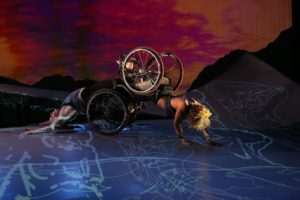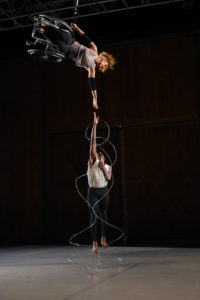Over the past several weeks, students and faculty in the School for Classical & Contemporary Dance (SCCDance) have worked virtually with guest artists from the disability dance company Kinetic Light. In courses ranging from choreography to dance lighting design, SCCDance students, like Stephanie Montes, have learned what it means to bring accessibility and equity to dance.
“The most important thing I learned from engaging with Kinetic Light is that access does not imply equity,” said Montes. “Simply having a disabled person on a stage does not mean that dance has become inclusive.”
That important distinction is one that the SCCDance wants to share with the broader campus community in the upcoming virtual event “On and Beyond the Stage: Practicing Disability, Access, Aesthetics & Tech” on March 16. Members of Kinetic Light, including founder Alice Sheppard, will speak about accessibility, inclusion and the disability arts movement.

Alice, a multiracial Black woman with short curly golden hair, wearing a sleeveless tank top, is crawling on her forearms with her knees in Laurel’s footplate. Laurel, a pale white woman also wearing a sleeveless top, is arching her back on the ground as she is dragged along the floor. Their wheelchair wheels are stacked and shine in the light. The sky in the background is full of deep red and orange sunset hues; blue and white projections of figures and constellations fall across the ramp and the floor. Photo by Chris Cameron, courtesy MANCC.
Kinetic Light differs from other performing arts companies that feature disabled dancers. It is an arts ensemble led by Sheppard, a disabled artist; disabled artists create, design, and perform the work; the work speaks to and emerges from disability aesthetics and disability culture; and the work is connected to the rich traditions and exciting contemporary conversations of disabled artists in all artistic fields.
The campus-wide event, supported in part by the College of Fine Arts’ Arts Programming and Diversity, Equity, and Inclusion Initiative Grant, signifies the university’s and the SCCDance’s commitment to recognizing diversity at “a grassroots level,” says Susan Douglas Roberts, Professor of Dance.
“To engage with Kinetic Light is to engage on the topic of accessibility. For the artists of Kinetic Light, this is not a separate topic but rather an integrated way of making and presenting art,” says Douglas Roberts. “It is an approach for all of us, not for a reserved few, to learn. We are re-working balances of power to create equity institutionally and to do so in both individual and group settings.”
Douglas Roberts says that Kinetic Light artists have challenged SCCDance students, the majority of whom are physically abled, to see through a different lens and to take action following their class engagements.

Alice Sheppard, a light-skinned multiracial Black woman with short curly hair, suspends majestically from the ceiling; one arm clasped to a cable that hooks onto her wheelchair, and another outstretched straight down towards the floor. Jerron Herman, a medium-height dark-skinned Black man with a beard and kinky high top black hair, jumps up towards Alice’s outstretched hand. He is looking directly up at her and his right and is just shy of meeting hers. His palsied left arm clings to his chest. Silver barbed wire cascades all around Jerron’s body, encircling him in a sculptural framework. Photo by Grace Kathryn Landefeld, courtesy Jacob’s Pillow.
Montes, who learned from several Kinetic Light artists in two different classes, says that the company confronts conventional thoughts about how dancers move.
“Disability dance isn’t lacking or falling short,” said Montes. “I’ve learned that as a creator of art it is important for me to make art that isn’t just accessible. Interpretation is inherent in art. What we must do is ensure that how we present interpretation is done in an ethical way.”
Additionally, Montes says that working with Kinetic Light has made her feel more responsible for advocating for accessibility in the arts. She hopes TCU students outside of the SCCDance will join the upcoming virtual event to educate themselves.
“This experience has embodied TCU’s mission ‘to educate individuals to think and act as ethical leaders and responsible citizens in the global community,’” said Montes. “We cannot be ethical leaders about topics we are uneducated in. I now feel empowered to go out and learn even more as I become an ally and an advocate for disability in the arts.”
The March 16 event, “On and Beyond the Stage: Practicing Disability, Access, Aesthetics & Tech,” is open to members of the TCU community via Zoom with advance registration.
